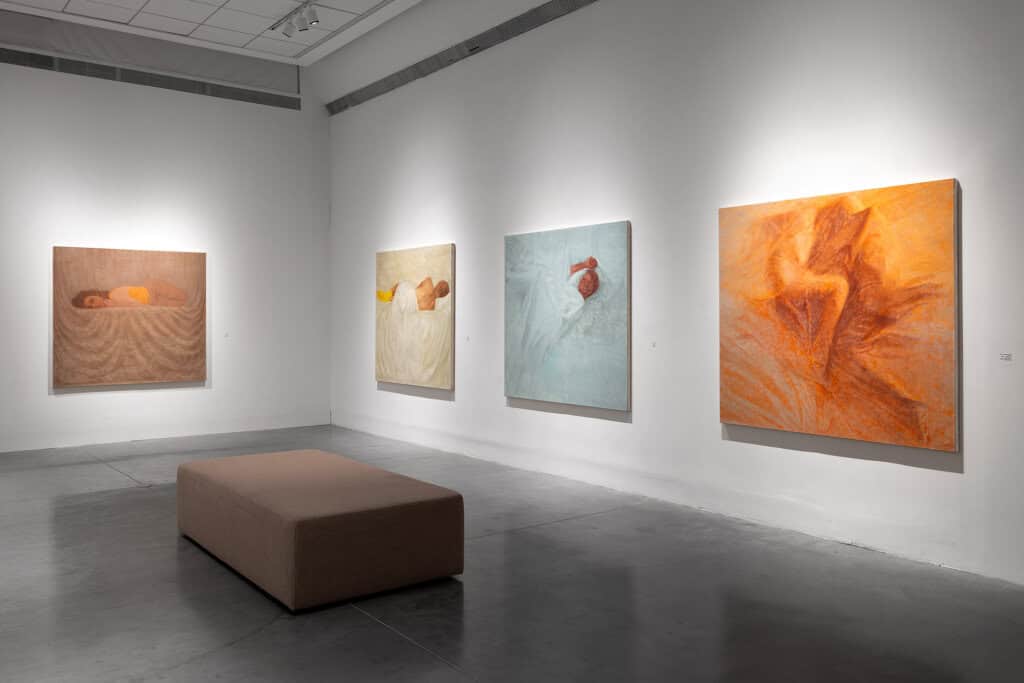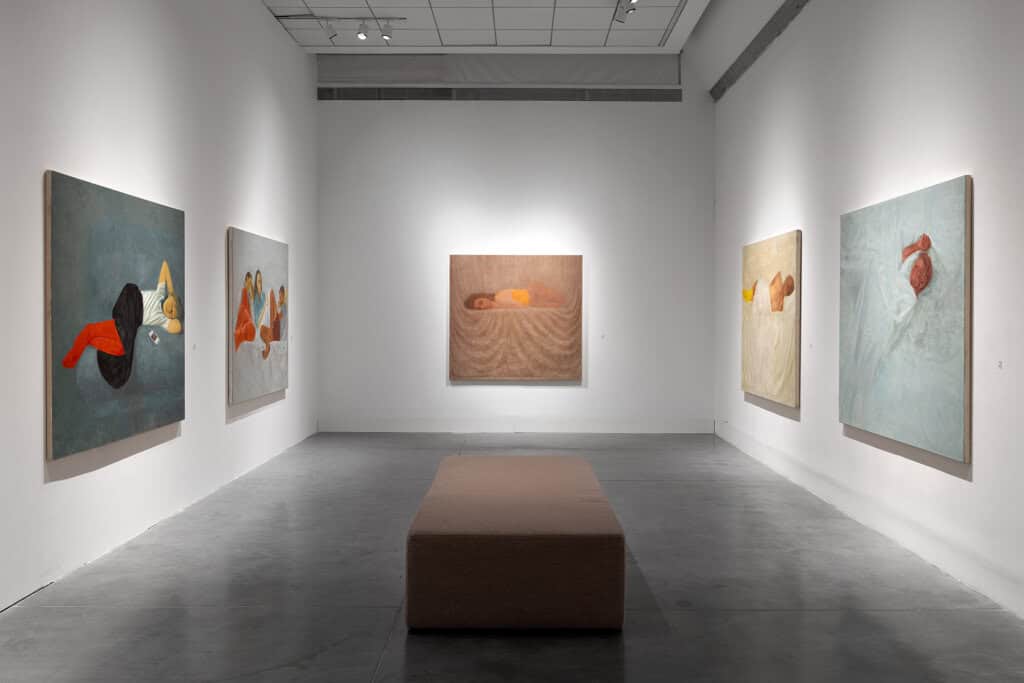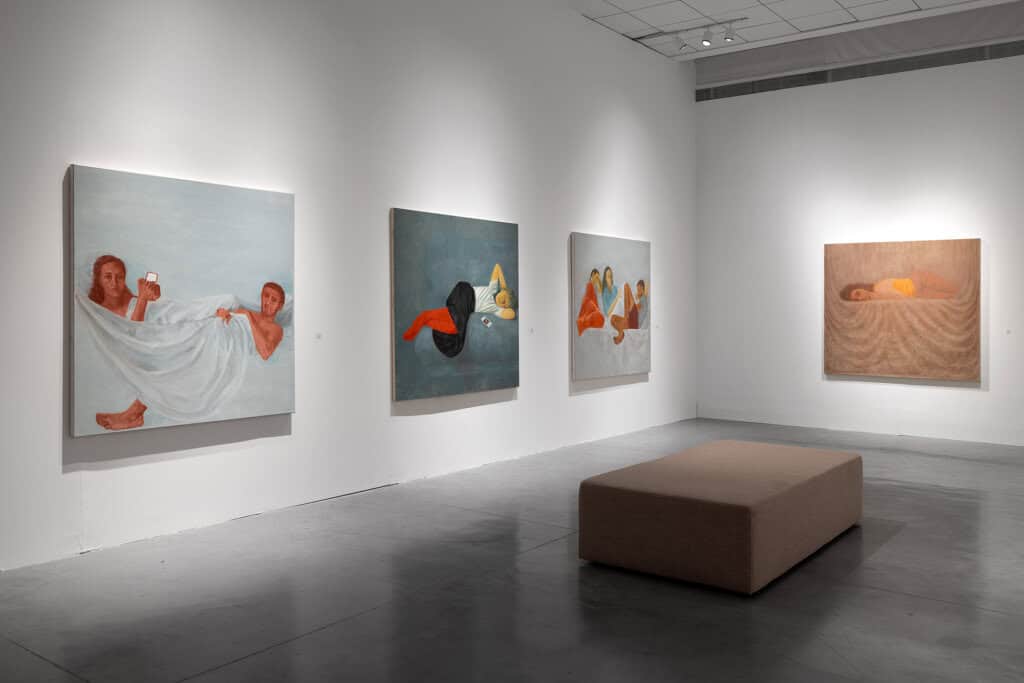Gabriella Klein: Night Train
Irena Gordon
24/07/2025 -
22/11/2025

“Everything in life is changing, fleeting, transient—like the sights seen through a train window,” is how Gabriella Klein describes artmaking. Painting is an illusion of representation, ever-shifting and providing the only possible freedom. It is the suspension of reality’s ceaseless flow in painting that carries it into another reality—one in which Klein is free to act as she pleases, with full control.
The paintings in the series Night Train are windows into a sequence of intimate scenes, portraying friends or family members. The figures lie or sit on beds or sofas, alone or in a group, amid bedding and fabrics, fully or partially clothed. The bed—setting for many of life’s situations: sleep and rest, sex, birth, and death—becomes a realm of existence both physical and dreamlike, evoking the unconscious and inviting reflection on the everyday and the banal.
The series evolved from a photograph taken by Klein of two friends on a train journey through India—an experience Klein herself has shared with her family numerous times. In the square canvases, created over three years, she paints the figures in their entirety for the first time, revealing and concealing parts of them. The bed, sheets, and fabrics become sculptural color fields—a painterly void that may, at any moment, become a representation of something in the world.
“I love the tension between stillness and motion; the figures are at rest, yet the train is in constant movement,” says Klein. “I associate trains with longing—a yearning to be elsewhere, to be with people who are far from me. In my paintings and drawings, I express that longing through daydream-like scenes—images of water and sea, bedding transformed into landscapes, curtains that conceal something unknown, my daughters’ hair, and figures in postures of rest or meditation.”
Textiles—a garment, a curtain, bedding, or simple pieces of cloth either hung or laid out—are a central element in Klein’s oeuvre. Ubiquitous, they signify the human body, the domestic. From this intimate materiality she ventures into spaces of estrangement and mystery, landscape and abstraction, rooted in the tradition of Western painting, where fabric has long symbolized status and beauty, sensuality and eroticism, identity and belonging, and above all—artistic virtuosity in the creation of illusion. As in the tale told by Pliny the Elder about the two Greek painters, Zeuxis and Parrhasius, who decided to hold a contest to create the perfect painting: Zeuxis painted grapes so lifelike that birds were deceived by their realism, but Parrhasius surpassed him by painting a drawn curtain so real that his rival asked to see the painting hidden behind it.
The stretched canvas—the painting’s surface—acquires a self-awareness when Klein depicts other cloths upon it, cascading, folded, draped, spread out. “There are countless ways to render fabric. I see it as a terrain for exploration,” Klein says, echoing Jacques Derrida’s analysis (in his essay on Antonin Artaud, “Maddening the Subjectile”) of the dialectic between the figures of the stretched canvas and the linen sheet: the former signifies the element of representation at the core of painting, which dictates the rules of the medium, while the soft sheet, impressed with the body’s form, is the other face of the canvas; an autonomous work that refuses to follow the rules.
In Klein’s paintings, the cool white-gray-blue hues of the sheeted expanses meet the vibrant, warm color fields of the figures’ garments and skin, while remembering the formative movement of the sculptural garment folds in classical art, the soft breeze that stirs the airy finery in Renaissance painting. At the same time, the expressions, gazes, and postures of the figures recall the timeless Fayum mummy portraits, the sunlit domesticity engulfing Berthe Morisot’s women, Picasso’s archaic figures, the dreamlike solitude in Lucian Freud’s paintings, Alice Neel’s direct gaze.
At times resembling three-dimensional reliefs, at times ancient frescoes, Klein’s paintings are striking in their materiality and their continual oscillation between figuration and abstraction. Likewise, the viewer’s gaze at them, while drawn into their sensual, dreamlike spaces, moves restlessly under and over the surface of the sheets.




